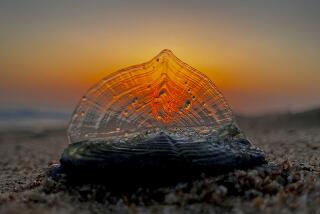State Colleges’ Research Vessel Yellowfin : Seagoing Classroom Helps Students Stay Competitive
An excited look swept across Prof. Don Maurer’s face as he scanned the clump of wet, black mud dredged from the bottom of Alamitos Bay off Long Beach.
“Really, really good stuff,” he told his class of about a dozen Cal State Long Beach students. And sure enough, close examination revealed much more than a lifeless ball of muck.
Maurer, dressed in a tattered yellow slicker and green-and-white baseball cap, hosed away at the ooze in a topside wash basin. He carefully extracted a polliwog-sized fish, a tiny shrimp, a worm and a miniature crab, and placed them in a petri dish for closer examination under a microscope.
The exercise was intended to show what type of sea life exists in varied ocean environments, such as at the bottom of a bay, the mouth of a river or among the seabeds in the open ocean. It is all part of a class on paleoecology, in which students are taught how to identify ancient environments based on the types of fossils found in the sediments.
Firsthand Experience
To give students a firsthand experience, Cal State Long Beach and the California State University campuses in Dominguez Hills, Fullerton, Los Angeles, Northridge and Pomona share a floating classroom--the research vessel Yellowfin.
Maurer said the use of the specially equipped boat for the nearly 4-hour expedition is invaluable, showing students existing sea life that they can compare with fossilized ancestors.
“It’s not just coming from the prophet’s mouth,” he said. “They can see it.”
Maurer is one of many Cal State instructors who use the 80-foot aluminum vessel as a teaching aid. The boat’s missions have been as varied as catching fish with line-and-hook near a reef to ferrying a group of recreation majors to desolate Santa Barbara Island where they set up camp for a week.
While other colleges and universities operate research vessels, few, if any, have boats reserved primarily for undergraduate instruction, said Anthony Moye, vice chancellor of academic affairs for the California State University system.
“If you just lecture about it theoretically, it is not the same if students have to run through it themselves,” said Murray Dailey, director of the Ocean Studies Institute based at Cal State Long Beach.
Latest Technology
He said the floating classroom has been set up to give science students firsthand experience with the latest research technology.
“It’s a competitive market out there. . .. We feel we need to have state-of-the-art, hands-on equipment. If they apply for a job with the same kind of equipment and sampling, it gives them a leg up,” said Dailey, a biology professor who coordinates use of the Yellowfin among the campuses.
The university system bought the boat for $300,000 2 years ago from a company that used it for research off Hawaii. Besides being already outfitted for scientific work, the boat is 30 feet longer than the old wooden fishing boat it replaced, the Nautilus. It has lab and deck space for twice as many students, can sleep 11 and has a wide beam that makes it steadier than the Nautilus.
“I don’t have as many students getting sick,” said Prof. Richard Bray, an ichthyologist at Cal State Long Beach who uses the boat to teach students about different types of fish. “When you have a boat rocking . . . and these fish are slopping around, it can be dangerous. The Yellowfin is so much more steady and stable.”
Besides a lab, the boat has dual radar- and radio-navigation systems, a depth meter, fish finder and special marine radios. Three crewmen are assigned to the boat full time. The budget for crew, fuel and maintenance totals about $310,000 a year. The university system is self-insured, negating the need for an expensive policy.
The Yellowfin’s skipper, Jim Cvitanovich, said his boat will crank along at “an honest 10 knots.” He was a crewman for 2 years before he became skipper of the Nautilus a decade ago. “It’s really a good boat job,” said Cvitanovich, son of a San Pedro fisherman. “You don’t have to catch fish to get paid.”
On a recent Saturday, the boat cut through the glassy morning seas en route to five different locations, each with a different type of ocean bottom, in Alamitos Bay. At each point, a crewman reeled a clamshell-type bucket off a winch on the stern to scoop up the muck for Maurer and his students to analyze.
The students liked the boat. Graduate student Chris Grant, 28, said he hopes that the oil company that employs him as a research assistant will charter the boat so he can collect samples of bottom sediments. The study would prove useful not only to the company, but provide the data he needs to complete his masters’ thesis as well.
He said the existence of certain “critters” in the samples could help point to new locations of oil in the Santa Barbara Channel.
More to Read
Sign up for Essential California
The most important California stories and recommendations in your inbox every morning.
You may occasionally receive promotional content from the Los Angeles Times.










